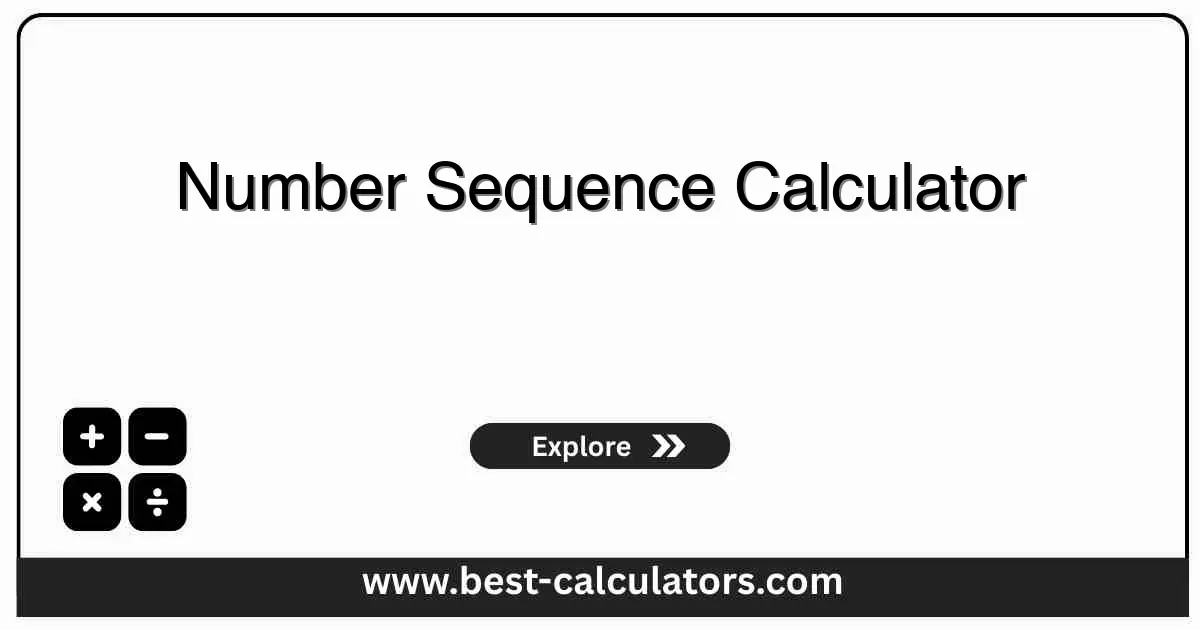Number Sequence Calculator - Find Patterns & Terms
Analyze and calculate number sequences including arithmetic, geometric, Fibonacci, and special sequences with instant pattern recognition
Number Sequence Calculator
Results
Enter parameters and click Calculate
What is a Number Sequence Calculator?
A Number Sequence Calculator is a free mathematical tool that helps you identify patterns, calculate terms, and find sums in various number sequences including arithmetic progressions, geometric progressions, Fibonacci sequences, and special number patterns. It provides instant analysis of sequence properties and generates subsequent terms automatically.
This calculator works for:
- Mathematics Students - Solve sequence problems and verify homework solutions
- Teachers and Educators - Demonstrate pattern recognition and sequence properties
- Competitive Exam Candidates - Practice arithmetic and geometric sequence problems quickly
- Researchers - Analyze numerical patterns in data and experiments
For advanced mathematical calculations and functions, use our Scientific Calculator to perform trigonometric, logarithmic, and exponential operations.
To calculate powers and exponential expressions, explore our Exponent Calculator for precise power calculations and scientific notation.
For analyzing data variability and statistical measures, check out our Standard Deviation Calculator to understand data distribution patterns.
How Number Sequences Work
The calculator uses mathematical formulas specific to each sequence type:
Key Sequence Concepts
Common Difference
In arithmetic sequences, the constant value added to each term. Can be positive, negative, or zero.
Common Ratio
In geometric sequences, the constant value by which each term is multiplied. Determines exponential growth or decay.
Convergence
A sequence converges if its terms approach a specific value. Geometric sequences converge when |r| < 1.
Pattern Recognition
Identifying the rule that generates sequence terms. Essential for predicting future values and finding formulas.
How to Use This Calculator
Select Sequence Type
Choose from arithmetic, geometric, Fibonacci, square, or triangular sequences
Enter Parameters
Input first term and common difference/ratio as needed
Specify Position
Enter which term to find and how many terms to sum
View Results
Get nth term, sum, and see the sequence pattern instantly
Benefits of Using This Calculator
- • Instant Pattern Recognition: Quickly identify sequence types and their mathematical properties.
- • Multiple Sequence Types: Support for arithmetic, geometric, Fibonacci, square, and triangular sequences in one tool.
- • Comprehensive Results: Calculate nth term, sum of n terms, and display sequence progression simultaneously.
- • Educational Value: Learn sequence formulas and understand how patterns develop mathematically.
- • Time-Saving: Eliminate manual calculations for large sequence positions and complex sums.
- • Accuracy Guaranteed: Avoid arithmetic errors in sequence calculations and pattern identification.
Understanding Sequence Properties
1. Arithmetic vs Geometric
Arithmetic sequences grow linearly (constant difference), while geometric sequences grow exponentially (constant ratio). Choose the correct type based on your pattern.
2. Positive vs Negative Growth
Positive differences/ratios create increasing sequences, while negative values create decreasing sequences. Ratios between -1 and 1 cause geometric sequences to converge.
3. Special Sequences
Fibonacci, square, and triangular sequences have fixed patterns. These don't require difference or ratio inputs as they follow predetermined formulas.
4. Large Position Values
Geometric sequences can produce very large or very small numbers for high positions. Use scientific notation if needed for extreme values.

Frequently Asked Questions (FAQ)
Q: What types of sequences can this calculator analyze?
A: This calculator supports arithmetic sequences (constant difference), geometric sequences (constant ratio), Fibonacci sequences, square numbers (n²), and triangular numbers (sum of first n natural numbers).
Q: How do I find the nth term of an arithmetic sequence?
A: For an arithmetic sequence, the nth term is calculated using the formula: nth term = a + (n-1)d, where 'a' is the first term, 'n' is the position, and 'd' is the common difference between consecutive terms.
Q: What is the formula for the sum of a geometric sequence?
A: The sum of the first n terms of a geometric sequence is: Sum = a(r^n - 1)/(r - 1), where 'a' is the first term, 'r' is the common ratio, and 'n' is the number of terms. This formula works when r ≠ 1.
Q: How does the Fibonacci sequence work?
A: The Fibonacci sequence starts with 0 and 1, and each subsequent term is the sum of the previous two terms: 0, 1, 1, 2, 3, 5, 8, 13, 21, 34, and so on. It appears frequently in nature and mathematics.